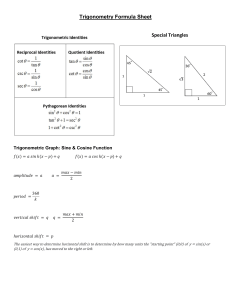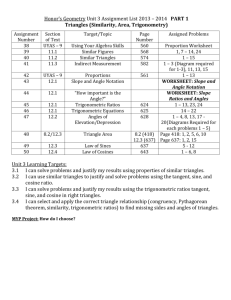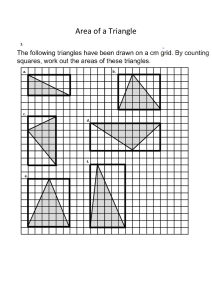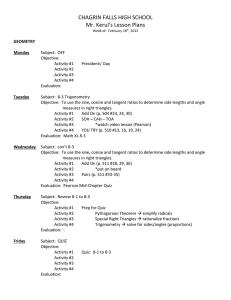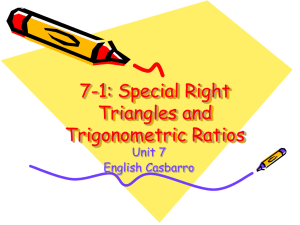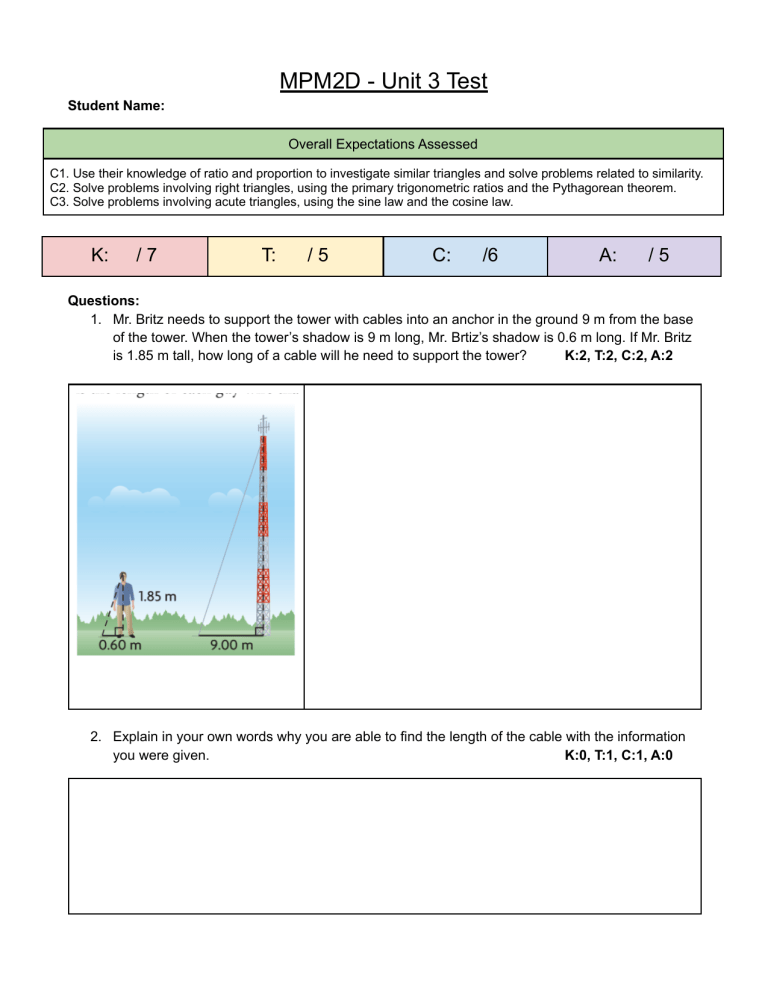
MPM2D - Unit 3 Test Student Name: Overall Expectations Assessed C1. Use their knowledge of ratio and proportion to investigate similar triangles and solve problems related to similarity. C2. Solve problems involving right triangles, using the primary trigonometric ratios and the Pythagorean theorem. C3. Solve problems involving acute triangles, using the sine law and the cosine law. K: /7 T: /5 C: /6 A: /5 Questions: 1. Mr. Britz needs to support the tower with cables into an anchor in the ground 9 m from the base of the tower. When the tower’s shadow is 9 m long, Mr. Brtiz’s shadow is 0.6 m long. If Mr. Britz is 1.85 m tall, how long of a cable will he need to support the tower? K:2, T:2, C:2, A:2 2. Explain in your own words why you are able to find the length of the cable with the information you were given. K:0, T:1, C:1, A:0 3. How much further does the plane need to fly to be directly above the ship? K:1, T:0, C:1, A:1 4. Solve for all unknown sides and angles in the triangle below. It will help to label the triangle’s vertices and sides that are unknown with letters. K:4, T:2, C:2, A:2 MPM2D Unit 3 Test Rubric Student Name: R: 0-49% Level 1: 50%-59% Level 2: 60%-69% Level 3: 70%-79% Level 4: 80%-100% Knowledge: How well did you demonstrate your knowledge and understanding of trigonometry? No answer was provided. Many errors while solving similar triangles. Some errors while solving similar triangles. Few errors while solving similar triangles. No errors while solving similar triangles. No answer was provided. Many errors while using the primary trigonometric ratios. Some errors while using the primary trigonometric ratios. Few errors while using the primary trigonometric ratios. No errors while using the primary trigonometric ratios. No answer was provided. Many errors while using the sine and cosine laws. Some errors while using the sine and cosine laws. Few errors while using the sine and cosine laws. No errors while using the sine and cosine laws. Thinking: How well did you demonstrate your critical thinking and creativity when solving problems? No answer was provided. Very little critical thinking can be seen. Critical thinking is displayed in some solutions. Critical thinking is displayed in most solutions. Critical thinking is displayed in all solutions. No answer was provided. Very little creativity is demonstrated when needed. Some creativity is demonstrated when needed. Creativity is often demonstrated when needed. Creativity is always demonstrated when needed. Communication: How well did you communicate your learning with full solutions showing all steps with proper notation? No answer was provided. Almost no work is shown. Some steps are included. Most steps are written. Full, complete solutions provided. No answer was provided. Did not use proper notation. Used proper notation, including measurement units, sometimes. Used proper notation and included units in most problems, where appropriate. Proper notation and units are included in all solutions, where appropriate. Application: How well did you apply your learning and skills to solve a real-world problem? No answer was provided. Very poor ability to solve real-world problems involving acute triangles. Overall Percentage Some ability to solve real-world problems involving acute triangles. Good ability to solve real-world problems involving acute triangles. Teacher Comments Excellent ability to solve real-world problems involving acute triangles. Grade
